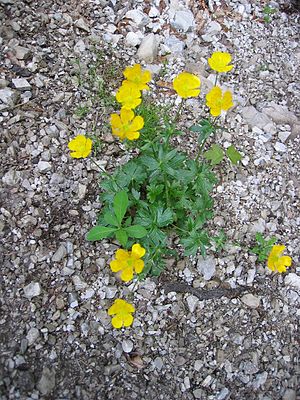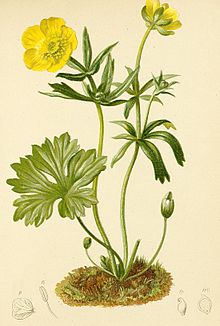Mountain buttercup
| Mountain buttercup | ||||||||||||
|---|---|---|---|---|---|---|---|---|---|---|---|---|

Mountain buttercup ( Ranunculus montanus ) |
||||||||||||
| Systematics | ||||||||||||
|
||||||||||||
| Scientific name | ||||||||||||
| Ranunculus montanus | ||||||||||||
| Willd. |
The mountain buttercup ( Ranunculus montanus ), more precisely called common mountain buttercup , is a species of the genus buttercup ( Ranunculus ) within the buttercup family (Ranunculaceae).
description
Vegetative characteristics
The mountain buttercup grows as a deciduous, perennial herbaceous plant and usually reaches heights of 25 to 30 (5 to 50) centimeters. It forms a bare rhizome , which is cylindrical or nodular with thin intermediate sections, as a persistence organ with fleshy roots. The upright, unbranched stem is protruding in the lower area and mostly hairy in the upper area.
The basal and alternate leaves on the stem are bare to scattered, with less than six trichomes per mm², hairy. The stalked basal leaves have a shiny, bald or slightly hairy leaf blade, which is deeply three-parted with irregularly cut to toothed sections. The seated stem leaves are three to seven parts. Their sections are lanceolate to linear-lanceolate and less than seven times as long as they are wide, blunt to just pointed and widest in the middle or just above the middle.
Generative characteristics
The flowering period extends from May to September. Usually only one, rarely up to three flowers stand on stem-round, uneven flower stalks.
The hermaphrodite flowers are radially symmetrical with a diameter of 2 to 3 centimeters . The flower base is only hairy at the top. The five petals are golden yellow. There are many stamens present. The attachment points of the stamens are bare.
The collective fruit contains 25 to 50 nuts , the beak of which protrudes slightly.
genetics
The mountain buttercup probably originated from a cross between the Carinthian mountain buttercup ( Ranunculus carinthiacus ) and the Grenier buttercup ( Ranunculus villarsii ) with subsequent chromosome duplication. Its chromosome number is 2n = 32.
Toxicity
The mountain buttercup is said to contain plenty of protoanemonin , so it must be considered poisonous.
Occurrence
The mountain buttercup is common in Europe. The distribution area includes the entire Alpine region , but also extends into the foreland and reaches the Swiss Jura and the Black Forest .
It thrives at altitudes from the valley up to 2800 meters. In the Alps and foothills of Central Europe, it occurs scattered at altitudes above about 600 meters; occasionally it appears in the Hegau . In the Allgäu Alps, it rises at the summit of the Kreuzeck in Bavaria to an altitude of 2370 meters. In Austria the mountain buttercup is common in the eastern Alps and rare in the central Alps ; he is absent in Vienna and Burgenland.
The mountain buttercup populated pastures , rich meadows and shallow bog near wetlands as well as sparse forests and scree in the mountains and preferred turf , mats , light woods, Schneetälchen , fens and debris . It occurs in societies of the associations Poion alpinae, Polygono-Trisetion, Erico-Pinion, in lower altitudes also the Molinion or Caricion davallianae. In the Alps it also occurs in societies of the class Thlaspietea.
This lime-loving species thrives best on calcareous, humus-rich loam soils that should be moist rather than dry.
Taxonomy
Ranunculus montanus was first published in 1799 by Carl Ludwig Willdenow Species Plantarum , 4th edition, 2, 2, page 1321.
literature
- Xaver Finkenzeller, Jürke Grau: Alpine flowers. Recognize and determine (= Steinbach's natural guide ). Mosaik, Munich 2002, ISBN 3-576-11482-3 .
- Manfred A. Fischer, Wolfgang Adler, Karl Oswald: Excursion flora for Austria, Liechtenstein and South Tyrol . 2nd, improved and enlarged edition. State of Upper Austria, Biology Center of the Upper Austrian State Museums, Linz 2005, ISBN 3-85474-140-5 .
- Jürgen Damboldt, Walter Zimmermann : Ranunculaceae. In: Gustav Hegi : Illustrated flora of Central Europe. Volume 3, Part 3: Dicotyledones. Part 1: (Nymphaeaceen, Ceratophyllaceen, Magnoliaceae, Paeoniaceen, Ranunculaceae). 2., completely reworked. Ed. Carl Hanser, Munich 1974, pp. 81–356.
- Jaakko Jalas, Juha Suominen: Atlas Florae Europaeae. Volume 8: Nymphaeaceae to Ranunculaceae. University Printing House, Helsinki 1989, ISBN 951-9108-07-6 .
- Elias Landolt : The species groups of Ranunculus montanus Willd. in the Alps and in the Jura. Cytological systematic examinations. Dissertation ETH, Bern 1954. Printed in: Report of the Swiss Botanical Society, Volume 64, pp. 9–84.
Individual evidence
- ↑ Ranunculus montanus Willd. In: Info Flora , the national data and information center for Swiss flora .
- ↑ a b Erich Oberdorfer : Plant-sociological excursion flora for Germany and neighboring areas . With the collaboration of Angelika Schwabe and Theo Müller. 8th, heavily revised and expanded edition. Eugen Ulmer, Stuttgart (Hohenheim) 2001, ISBN 3-8001-3131-5 , pp. 412 .
- ↑ a b c Dietmar Aichele, Heinz-Werner Schwegler: The flowering plants of Central Europe . 2nd Edition. tape 2 : Yew family to butterfly family . Franckh-Kosmos, Stuttgart 2000, ISBN 3-440-08048-X .
- ↑ Erhard Dörr, Wolfgang Lippert : Flora of the Allgäu and its surroundings. Volume 1, IHW, Eching 2001, ISBN 3-930167-50-6 , p. 541.
- ^ Manfred A. Fischer, Wolfgang Adler, Karl Oswald: Excursion flora for Austria, Liechtenstein and South Tyrol . 2nd, improved and enlarged edition. State of Upper Austria, Biology Center of the Upper Austrian State Museums, Linz 2005, ISBN 3-85474-140-5 .
Web links
- Ranunculus montanus Willd., Mountain buttercup. In: FloraWeb.de.
- Ranunculus montanus agg., Mountain buttercup (species group). In: FloraWeb.de.
- Mountain buttercup . In: BiolFlor, the database of biological-ecological characteristics of the flora of Germany.
- Profile and distribution map for Bavaria . In: Botanical Information Hub of Bavaria .
- Ranunculus montanus Willd. In: Info Flora , the national data and information center for Swiss flora . Retrieved October 20, 2015.
- Thomas Meyer: Data sheet with identification key and photos at Flora-de: Flora von Deutschland (old name of the website: Flowers in Swabia ).
- Ranunculus montanus - data sheet from Flora Italiana - Schede di botanica .
further reading
- Elvira Hörandl, Khatere Emadzade: The evolution and biogeography of alpine species in Ranunculus (Ranunculaceae): A global comparison. In: Taxon , Volume 60, Issue 2, 2011, pp. 415-426. PDF.
- Khatere Emadzade, B. Gehrke, HP Linder, Elvira Hörandl: The biogeographical history of the cosmopolitan genus Ranunculus L. (Ranunculaceae) in the temperate to meridional zones. In: Molecular Phylogenetics and Evolution , Volume 58, 2011, pp. 4-21.
- Elvira Hörandl, Khatere Emadzade: Northern Hemisphere origin, transoceanic dispersal, and diversification of Ranunculeae DC. (Ranunculaceae) in the Cenozoic. In: Journal of Biogeography Volume 38, 2011, pp. 517-530.
- Khatere Emadzade, C. Lehnebach, P. Lockhart, Elvira Hörandl: A molecular phylogeny, biogeography and classification of genera of Ranunculeae (Ranunculaceae). In: Taxon , Volume 59, 2010, pp. 809-828.
- O. Paun, P. Schönswetter, M. Winkler, Intrabiodiv Consortium, A. Tribsch: Historical divergence vs. contemporary gene flow: Evolutionary history of the calcicole Ranunculus alpestrisgroup (Ranunculaceae) in the European Alps and the Carpathians. In: Molecular Ecology , Volume 17, 2008, pp. 4263-4275.
- Elvira Hörandl, O. Paun, JT Johansson, C. Lehnebach, T. Armstrong, L. Chen, P. Lockhart: Phylogenetic relationships and evolutionary traits in Ranunculus sl (Ranunculaceae) inferred from ITS sequence analysis. In: Molecular Phylogenetics and Evolution , Volume 36, 2005, pp. 305-327.
- TG Tutin, CDK Cook: Ranunculus. Pp. 269-290. In: TG Tutin, VH Heywood, NA Burges, DH Valentine, SM Walters, DA Webb, (Eds.): Flora Europaea , Volume 1, Psilotaceae to Platanaceae , 2nd Edition, Cambridge University Press, 1993.
- Elias Landolt: The species group of Ranunculus montanus Willd. in the Pyrenees and other European mountains west of the Alps. In: Report of the Swiss Botanical Society , Volume 66, 1956, pp. 92–117.


